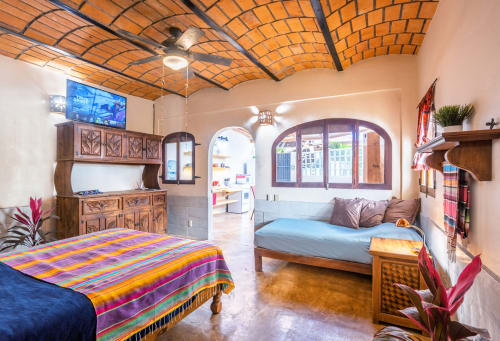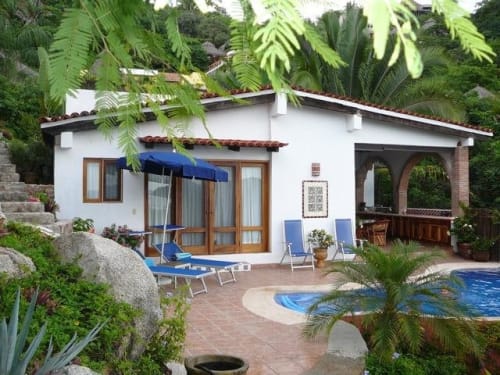SayulitaLife.com members can easily save favorites for vacation rentals, local businesses, real estate and more.
Sign In Create free accountList Your Property
Pueblo Mágico: Keeping the Conversation Going
.jpg) As plans for Sayulita’s Pueblo Mágico program unfold, Marcos Scott, president of the Pueblo Mágico Committee is working to keep all residents of Sayulita informed as to the progress that is being made. The program has inspired a lot of discussion — both pro and con. Members of the Pro Sayulita communications committee recently met with Scott to gather and report information about the latest developments.
As plans for Sayulita’s Pueblo Mágico program unfold, Marcos Scott, president of the Pueblo Mágico Committee is working to keep all residents of Sayulita informed as to the progress that is being made. The program has inspired a lot of discussion — both pro and con. Members of the Pro Sayulita communications committee recently met with Scott to gather and report information about the latest developments.
To begin with — what is a Pueblo Mágico?
In 2001 Mexico’s Secretariat of Tourism (SECTUR) joined forces with state and municipal governments to recognize and provide support for a selection of pueblos that possess extraordinary natural beauty, cultural riches, or historical significance.” These towns are considered to offer tourists a “magical” experience.
The Mexican Tourism Board found certain characteristics such as local culture, important monuments and architecture, and alternatives to traditional tourism such as eco-tourism and extreme sports were already attracting tourists. Some of these towns, however, were in need of support to develop the infrastructure needed to cope with the influx of people into their areas.
By 2012, 83 towns, representing all 31 states of Mexico, had received the designation of “Pueblo Mágico.” Sayulitans will be familiar with many of them such as: Real de Catorce, San Luis Potosi; Tapalpa, Jalisco; Pátzcuaro, Michoacán; Dolores Hidalgo, Guanajuato; San Cristóbal de las Casas, Chiapas; and, of course, one of our favorites — Tequila, Jalisco. (A complete list in English can be found on Wikipedia.)
This past November, SECTUR, along with the federal and state governments, decided to add 12 villages to the Pueblo Mágico program. Sayulita is fortunate to be one of those villages.
How will being a Pueblo Mágico benefit Sayulita?
Probably the most tangible and desirable benefit for any Pueblo Mágico is money. Marcos says that $500 million pesos each year is budgeted for Pueblos Mágicos. The amount received by each town depends on the projects each is undertaking, however, the potential is for each town to receive in the neighborhood of $400,000 U.S. dollars per year for the first five years they are in the program. Those five years are critical in that during those years the towns have the opportunity to significantly improve their infrastructure.
The second benefit is that Pueblos Mágicos become a priority for municipal, state and federal governments. Sayulita’s nearest governing body is in Valle de Banderas, seat of the municipal government, which has the difficult job of governing 37 villages.
“My hope is this is a way we can have a respectful conversation with government,” Scott says. “The various levels of government sign on to support the development of the Pueblo Mágico, and — with input from the town — provide funding and assistance as long as the program is in place.”
While Sayulita’s plan is still evolving, the list of priorities so far includes: upgrading the waste-water treatment plant, improving roads, traffic and parking, preserving green space, enhancing public works and urban planning.
This list is only a beginning, Scott says. Under each item, other issues arise in a natural progression. For example, one topic of conversation has been on street vendors and restaurants that have tables in the street — no one wants to displace our beloved “cake lady.”
“Street life is an essential part of the character of Sayulita,” Scott says. “But of course it must be regulated so as not to inhibit traffic flow and create problems with parking. The Pueblo Mágico officials are particularly interested in ‘streetscapes,’ so the question is, how do you establish some parameters for these activities without threatening the contribution they make to the charm of our town?”
There are a lot of issues to be worked on. The 10 committees which have been established to do this work are discussed further on in this article.
The third benefit is less tangible than the first two, but it is equally important. Marcos calls it “social consequences.” The process of becoming a Pueblo Mágico requires a broad range of Sayulita’s civil organizations such as the Charros, Ejido, Commerciantes (Sayulita business association), fishermen and Pro Sayulita to communicate and work with each other on the application.
“We want this process to be inclusive,” Scott says. “We’re open to hearing from representatives from all sectors. In the long run this is going to be good for Sayulita. We will have better communication with our governing bodies, and better communication within our own community.”
When the plan is complete, the Pro Pueblo Magico committee will continue to supervise the roll-out of the program although individual committee members will change. The Delegado, Jesus Rodriguez, is also a critical factor in the picture. Although he is not on a committee, he is the official representative of our town to Valle the committee is working hand-in-hand with his team.
Many hands — and it’s still heavy lifting
The 10 committees must submit the final plan on April 15, 2015. After it has been submitted there will be a physical inspection by Pueblos Magicos officials to ensure the problems cited and their solutions are in keeping with the Pueblo Mágico program. Scott is hoping to see individual reports from the committees by the end of March so the committee heads can pull the entire plan together. SECTUR is scheduled to announce the 12 new Pueblos Mágicos by July 30,2015.
“It is a big application and it is taking time to create an organization that has equal access and listens to everyone’s needs,” Scott says. “There has been a lot of controversy as to who is in charge. My goal is to have the process be all-inclusive.”
The committees meet on a regular basis and anyone with concerns about a specific section of the plan is welcome to speak at a committee meeting, or to join a committee.
“If you want to join you need to be prepared to roll up your sleeves and put in some serious work,” he says.
Scott also asks that groups who want to have their voices heard get together and elect one person to represent them at a meeting.
“It is very time-consuming to have several different individuals speak on the same issue, which is why we are asking groups to put forth one person to speak for them. We would also like to see a list of signatures of the people that speaker represents,” he says. “We hope to have input from all different perspectives, but we need to receive that input in an efficient manner.”
Since the committees are all-volunteer, meetings are scheduled at the convenience of the members. If you or someone you know would like to be present at a committee meeting (all are conducted in Spanish) contact Scott at: mascbr@gmail.com.
Scott’s take on Sayulita and the Pueblo Mágico program
As the saying goes “change is inevitable” and Scott feels that the changes Sayulita has gone through over the past few decades have been positive overall. Whether change occurred due to tourism, another industry or just the growth of the original families who live here, there would have been change.
“You do lose stuff with progress, but in general people’s lives here are better. No one dies of a common disease. When I first came, few people went past the Primaria — now many go to our local Secondaria or go further for more education and training,” he says. “Everyone in this town has benefited from tourism.”
The Pueblo Mágico program is a new model for tourism in Mexico, which creates a whole new economy, he says. It gives Sayulita the opportunity to set a direction for future change. Each town in the program is different, and by allowing each to create its own plan rather than trying to apply a cookie-cutter approach, Mexico allows each Pueblo Mágico to retain its own essence.
“We don’t want big hotels or chain stores. Six-story buildings on the beach would completely change the flavor of Sayulita. The intention of the program is to help Sayulita retain its charming, small town flavor,” Scott says. “My gut feeling is that the scales are weighted in our favor towards obtaining the Pueblo Mágico designation and I don’t see the town galvanizing against it. Ultimately it’s in the best interest of Sayulita, just as it is in our best interest to become a Pueblo Mágico.”





